 As approved for publication by Phil.Trans A 5/12/18:
C Windsor 2019 Phil.Trans A 2141
As approved for publication by Phil.Trans A 5/12/18:
C Windsor 2019 Phil.Trans A 2141
Can the development of fusion energy be
accelerated? An introduction to the proceedings
Colin Windsor
Tokamak Energy Ltd, 173, Brook Drive, Milton Park, OX14 4SD, UK
https://orcid.org/0000-0002-9030-5849
Keywords: Fusion energy, tokamaks, superconductors
*Author for correspondence (colin.windsor@tokamakenergy.co.uk).
Summary
This introduction reviews the unique opportunity of fusion power to deliver safe, carbon-free, abundant, base-load power. The differences with fission power are considered: especially why a Chernobyl, Three Mile Island
or Fukishima accident could not happen with a fusion reactor. The Lawson triple product is introduced, along
with tokamaks, or magnetic bottles, whose ability to approach close to the fusion burn conditions has so far
put them above their competitors. Our last fusion power Discussion Meeting was organised by Derek
Robinson FRS in 1998, and the progress since then is reviewed. Tokamaks are introduced, and the advantages
of spherical tokamaks are listed along with the special engineering challenges that they introduce. Their key
advantage is high plasma pressure, and the important beta parameter indicating the efficiency of the magnetic
field use is introduced. High temperature superconductors are described along with the opportunities they
allow for higher magnetic fields at higher current densities and more modest cryogenic temperatures. The
question posed is whether the two developments of spherical tokamaks and high temperature
superconductors could lead to more economical fusion power plants and faster development than the current
route through ITER and DEMO.
This article is part of a discussion meeting issue 'Fusion energy using tokamaks: can development be accelerated?'.
Why we need fusion energy?
Fusion energy already dominates our energy use, for the sun (figure 1) is our solar system's fusion power
plant, providing us now with the energy to power our solar voltaic cells and to make the wind blow, and in
the past through photo-synthesis to capture carbon dioxide and create our heritage of fossil fuels, coal, oil and
gas. It is now nearly 100 years ago, in 1920, that astro-physicist Eddington in his address to the British
Association entitled "The Internal Constitution of the Stars" described the mechanism that the sun uses to
sustain its energy production. His address is still with us on the web [1]. It included the prophetic statement:
"This reservoir can scarcely be other than the sub-atomic energy which, it is known, exists abundantly in all
matter; we sometimes dream that man will one day learn how to release it and use it for his service. The store
is well nigh inexhaustible, if only it could be tapped. There is sufficient energy in the sun to maintain its
output of heat for 15 billion years."
It was an idea whose time had come. In 1905 Einstein [2] had shown that through relativity, energy and mass
were interchangeable through the famous E=mc2 equation. In that same year of 1920, Aston [3] had carefully
measured the masses of many of the elements and noted that they did not simply scale with the number of
nuclides in the atom. Figure 2 shows this excess energy for each nuclide plotted against the atomic
number. It is seen that there is a broad minimum at around iron with atomic number 26. This is the reason
why 90% of the earth's inner core is made from iron! There is relative instability at much higher or much
lower atomic numbers than can release this energy. Fusion is the process by which light nuclei such as
deuterium 2H and tritium 3H come together to make helium 4He and a neutron in the reaction:
2D + 3T = 4He + n +17.6 MeV (1)
This nuclear reaction requires the deuterium and tritium ions to have enough energy, or temperature, to
overcome the familiar Coulomb repulsion of their positive charges. As the separation approaches nuclear
diameters, quantum interactions take over, but the energies required for D-T fusion are still of order 10 keV, or
more than 100 million degrees K. This presents a real challenge for the realisation of fusion power.
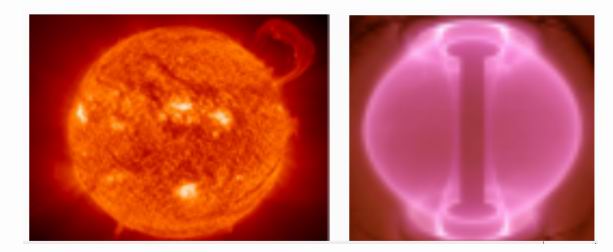
Figure 1. The sun (left) is our own solar system's fusion power plant, but with the plasma confined by gravity. The objective is to make
our own fusion power plant on earth using tokamaks with confinement by magnetic fields as in the START tokamak (right)
The 17.6 MeV of fusion energy from each reaction comes directly from the difference in mass between the
deuteron + triton and the helium + neutron masses. From conservation of momentum the energy is split
roughly 4:1 between the lighter neutron and the 4-times heavier helium, so that the neutron energy is the
famous 14.1 MeV and the alpha particle carries the remaining 3.5 MeV. There are two reaction products. The
neutron (n) has the most energy, which may be used to heat up a water jacket to make electricity and can also
be used to produce more tritium from the breeding reaction. The stable helium nucleus or alpha particle
carries the remaining 3.5 MeV of energy, but its charge means that it interacts with the electrons in the plasma
and gives up its energy rapidly so helping to sustain the ion temperature and the fusion reaction.
Our world is running out of options for generating sustainable, safe, CO2-free, base-load electricity. Base-load
can be defined as capacity available for most of most days. Some of these options are listed in table 1. None of
us quite expected the very rapid decrease in solar panel costs that has taken place over the last decade. There
is now "Swanson's law" [4]: the observation that over two decades, the price of solar photovoltaic modules
dropped 20 percent for every doubling of cumulative shipped volume. It demonstrates well the utility of
multiple-of-a-kind manufacture. Wind power has followed a similar if less dramatic path. But the intermittent
nature of both sources makes them unable to contribute to the base-load on cloudy wind-less days. Such days
can persist for months.
Perhaps one day, battery power will solve this problem but not yet. The biggest batteries so far have been of
order 32 MWh and the UK daily electricity use is around 1TWh so there remains a big gap to be filled on
cloudy, wind-less winter months. Coal, oil and gas will always remain as precious as raw resources, of finite
magnitude, useful in many ways. But burning them for heat seems not part of a sustainable planet. The CO2
they produce can in principle be captured by the technique of carbon sequestration, where the CO2 is frozen
out from the power station exhaust gases and pumped to some old gas field for storage. In practice this
technique has not yet proved commercially viable, and no such plant exists at present. Burning coal, with its
associated sulphur dioxide emissions, is also a serious health hazard by any standards.
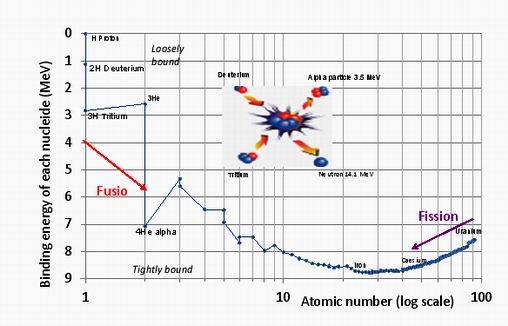
Figure 2.
The graph shows the excess energy of different nuclei plotted against atomic mass. The very light atoms have a high excess energy and can
become more stable by fusing together to produce larger nuclei. Heavy nuclei can become more stable by splitting up to produce fission products of
intermediate mass.
Geothermal and hydro share with coal, oil and gas the fact that they are not uniformly available over our earth
in the quantities needed to provide base-load power. Gas pipelines can partially overcome this but carry the
risk that supplies can be cut for political reasons. Electricity interconnectors carry a similar risk, and until we
have an interconnector circling the globe, there is the problem that cloudy, wind-less weather can persist over
whole continents!
Fission power ticks many of the boxes, although fast reactors, which breed their own fissile material, are
necessary for truly sustainable energy. Fission energy, which the UK pioneered, has served us well, but it is
not without risk and its public acceptance is fragile. There are three serious risks, as illustrated in figure 3:
i) A fission reactor carries within its core a great deal of fuel, which in the wrong circumstances can
lead to a catastrophic criticality as at Chernobyl.
ii) After a fission reactor has been running for some time it contains appreciable quantities of highly
radioactive fission products. If their containment is breached, as at Three Mile Island, serious
contamination can result.
iii) After a fission reactor is shut down for any reason, there is a good deal of "delayed heating" as its
fuel continues to produce enough heat to melt the core, as at Fukushima.

Figure 3. The three accidents that changed the public acceptance of fission power, and why they are not an issue in fusion reactors. (a) In a fusion
reactor, fuel is continually injected so that there is no possibility of a "criticality" as at Chernobyl, (b) the fusion products of alpha particles and neutrons
are benign compared with the release of highly active "fission products" as at Three Mile Island, (c) when a fusion reactor is shut down there is no
"delayed heat" from fuel radioactive decay as at Fukushima.
Fusion power does not suffer from any of these three possibilities. The tritium/deuterium fuel is
continuously injected into the reactor, so there is only enough fuel to sustain the reaction at its current level.
The fusion products are the relatively benign helium nuclei and neutrons. There is no possibility of delayed
heating when a fusion reactor is stopped. The high energy neutrons cause damage to materials and activation,
but these are not life-threatening issues.
We are left with fusion energy as the one option that ticks all the boxes!
| Source | Sustainablity | Safety | CO2-free | Base-load |
| Wind | √ | √ | √ | - |
| Solar | √ | √ | √ | - |
| Coal | - | - | - | √ |
| Gas/Oil | - | √ | - | √ |
| Geothermal | √ | √ | √ | - |
| Hydro | √ | √ | √ | - |
| Fission | √ | - | √ | √ |
| Fusion | √ | √ | √ | √ |
Table 1. Sources of energy, and the degree to which they satisfy the criteria of long-term sustainability, safety, carbon dioxide free emissions and
capability for base-load generation. Fission needs the fast reactor for long-term sustainability and fusion needs tritium breeding.
What is a tokamak
In 1955 John Lawson at Harwell produced the classified report, now available to all [5], showing that the
conditions for fusion could be written in the form: nTτE > 2.1021 m-3 keV s, where n is the density, say ~4.1020
m-3, T is the plasma temperature, say ~15 keV and τE is the energy confinement time say ~0.3 s. As John
Lawson said at the time, "even with the most optimistic assumptions, the conditions . . . are very severe." If the
density and temperature conditions are expressed as a plasma pressure in atmospheres, it comes out as
around 2000 atmospheres! How can this very high pressure be contained? Containment is easy on the sun,
which has its own gravity. Here on earth, there are few options, but magnetic forces are one way appropriate
for containing the high pressure, high-temperature plasma. Figure 4 shows the design sketched by George
Thomson in a 1946 patent [6].

Figure 4. The figure from the Thomson patent showing how fusion could be confined within a toroidal magnetic field. The plasma
current is generated as the secondary winding of a transformer [6].
A circular torus contains the plasma, and a transformer is made with the torus as the secondary winding. A
pulse of current down the primary circuit induces a toroidal current in the plasma, which heats up from ohmic
resistance and is kept in the torus shape by the "pinch" effect of the magnetic field induced by the plasma
current itself. The pinch effect dates from 1905 when Pollock and Barraclough [7] noticed that a tubular copper
pipe in a lightening conductor collapsed onto itself as shown in figure 5. Current on the edge of a current
carrying wire feels the poloidal magnetic field from the wire, which creates an inwards force on the current
carrying wire. The same force creates a powerful inward pressure on the current-carrying centre column of a
spherical tokamak.

Figure 5. The pinch effect, discovered in 1905 [7]. A current carrying wire suffers a compressive force due to the magnetic
field from the wire producing a force perpendicular to the wire surface. Figure by Brian James, CC BY-SA 3.0,
https://commons.wikimedia.org/w/index.php?curid=17808121
The ZETA experiment at Harwell in 1957 was an example of a pinch effect torus. It showed much promise and
produced copious neutrons, but these proved to be not the expected fusion neutrons but photo-neutrons from
the high energy "runaway" electrons created by the high magnetic fields. The main reason for the failure to
produce fusion neutrons was plasma instabilities, which have been the bugbear of fusion ever since. They
reduced the energy confinement time to milliseconds, from the seconds expected from conventional particle
Coulomb collisions. Anyone who has played with a plasma ball will have noted the plasma filaments are
never still but continually suffer "kink" distortions.
Progress was made in Russia in the sixties where it was realised by Shafranov that the toroidal field BT along
the path of the plasma torus was a key variable for improving stability and so plasma temperature. Stability
was improved according to a safety factor q=aBT/(R0BP) where a is the plasma minor radius and R0 its major
radius. This needed to be greater than about three for stability. As illustrated in figure 6, the period of the
paths threading the torus governed by the toroidal field needs to be short compared with the period around
the length of the torus governed by the poloidal field. If an aspect ratio A is defined as the ratio of the plasma
major and minor axes A=R0/a it is seen that q= BT/(ABP) ~>3 and that stability is generally improved for low
aspect ratios. It is this improved stability from the higher toroidal field, which defines a tokamak, and changed
the direction of fusion research.
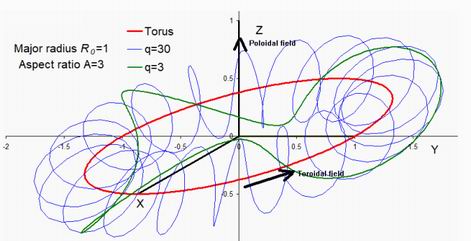
Figure 6. Particle orbits around a toroidal plasma with different safety factors q. This is the ratio of the number of orbits threading the
torus to the number around the torus. It should be higher than around three for stability.
With better stability there should be higher plasma temperatures. At the height of the cold war in 1969 Derek
Robinson FRS was part of the team, the "Culham five", that went to Moscow and first showed, using laser
Thomson scattering, that temperatures in the T3 tokamak were indeed as favourable as had been claimed.
Figure 7 shows him on the left with Volodya Sannikov, a co-author with him when the results were first
presented in 1969.

Figure 7. Derek Robinson FRS and Volodya Sannikov, co-authors of the paper presenting the T3 tokamak temperature results [8], at a meeting in
Dubna in September 1969. He was the Russian contact for the Culham team. (Courtesy of CCFE)
Progress in the last twenty years
Derek Robinson sadly died at the height of his powers in 2002, and the fusion community owes him a great
debt. He was the lead organiser 20 years ago in 1998 when the last Royal Society Discussion Meeting on fusion
power "The approach to an ignited plasma" was held.
The proceedings of that meeting continue to be a good read [9]. The introductory talk by Roy Bickerton [10]
was on the "History of the approach to ignition". Figure 8 shows his 1998 predictions for the future with ITER
operational in 2005, and DEMO in 2025!

Figure 8. A figure from the talk by Bickerton at the 1998 Discussion Meeting [10]. It shows ITER operations beginning in 2005.
John Sheffield prophetically mentioned "global warning", which was to change the public perception of the
need for fusion power. Martin Keilhacker presented results from the successful JET 1997 D-T campaign,
which proved that serious fusion power of 16 MW could be generated on earth. This record power has never
been exceeded. Derek Robinson presented the spherical tokamak START results with its record β, the ratio of
the plasma pressure to the pressure of the magnetic field required to contain the plasma. This important result
was to open the field of spherical tokamaks, leading to the possibilities for smaller fusion power plants aired
at this meeting. Farrokh Najmabadi talked of fusion power and the Aries project with its promise of GW
electric power at 7.7 US cents per kWh, but the project was never funded. Joe Kilkenny talked of inertial
fusion. The Livermore National Ignition Facility prediction was confidently expected to reach ignition by
firing enough energy at a tiny "hohlraum" containing a frozen pellet with a few milligrams of the deuterium
and tritium fuel. Calculations had suggested that success was near, but so far, the fusion power produced, has
only been of order 1/3 of that needed for ignition. This is the reason that inertial fusion was not part of this
meeting. Robert Aymar presented the ITER design and I remember the excitement we all felt that this project
was leading to a burning plasma. His talk concentrated on convincing the meeting that the physics of the
design was right.

Figure 9. The progress in the triple product towards fusion, compared with the Moore's law for transistor performance. Both showed a
power law, doubling around every two years [11]. From http://www.fusenet.eu/sites/default/files/moores_law.jpg
The twenty years since then have been something of a setback. Figure 9 shows a figure from the European
Fusion Educational Network [11]. The lower line in red squares shows Gordon Moore's law for transistors
with a doubling of capacity every 2 years. The upper blue line with circles shows the triple product of plasma
density, pressure and confinement time that John Lawson from Harwell derived in 1955 [3]. It increases
slightly faster with a doubling time of 1.8 years. A little research shows that Moore's law has continued
certainly up to 2016, but not so for fusion. According to the plot, the triple product goal for ITER should have
been achieved around 2008, but in 2018 the target for ITER tritium operations was 2035 [5]. It was the purpose
of this Discussion Meeting to ask if development could be accelerated.
In one sense we all know that one issue is the ITER project whose budget became a large fraction of the
national fusion associations and their top priority. I can still remember the excitement that I felt in the late
1980s when the ending of the cold war was sealed by the agreement between Gorbachov and Reagan to turn
their swords into ploughshares by building ITER. We all accepted that this was the way forward: sharing our
expertise so that the whole fusion world could join in making whatever was needed to approach an ignited
plasma. In this 2018 Discussion Meeting no one said a word against ITER. The whole fusion community want to see
it built. No photos of its construction were presented, so figure 10 is given as an example from 2018.
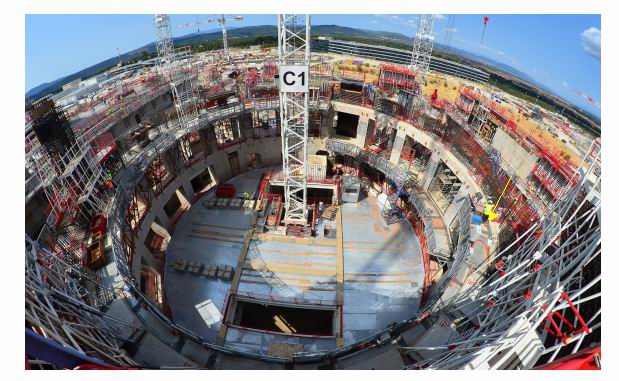
Figure 10. The ITER tokamak building in 2018. The yellow arrow indicates a man. Courtesy ITER
https://www.iter.org/doc/www/content/com/Lists/WebText_2014/Attachments/236/lid_final_from_above_small.jpg
What can we learn from ITER's 50-year long story illustrated in figure 11? Why has the timetable in
Bickerton's figure not been achieved? The answer is clear in retrospect. ITER is an excellent example of a
"megaproject", technically a project whose cost is over $1B, (The ITER cost is above $20B). Studies of past
megaprojects show that cost and time overruns are the norm rather than the exception, and that the cost
overun tends to increase with the size of the project [12].
One reason is that they tend to extend the boundaries of what has been done before and so encounter
unpredicted problems leading to unexpected costs and delays. Another reason is that megaprojects often
become too big for one company, one country, even one continent, and project management becomes difficult
with long chains of responsibility. In ITER's case, these problems were nicely documented in the report by
Madia and Associates [13] who made many suggestions for improvements. Today these sound commonplace,
even obvious: like "Develop a realistic project schedule". Time will tell if a difference has been made.
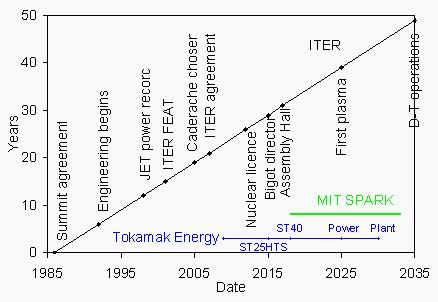
Figure 11. Some timescales for fusion projects. The ITER project is close to 50 years, the Tokamak Energy and MIT projects, which are
detailed in the proceedings, are close to 15 years. The ITER details are from the detailed time-line of milestones documented on their
website: https://www.iter.org/proj/itermilestones.
Spherical tokamaks
It was over thirty years ago in 1983 that Sykes, Turner and Patel [14] and later Peng [15] and Peng and
Strickler [16] predicted the high plasma pressures β possible with low aspect ratio spherical tokamaks. βE is the
ratio of the plasma pressure ppla = n.kT) to the magnetic pressure
(pmag = B2/
2μ0). The theory showed that β
could indeed be raised by a combination of low aspect ratio, and high elongation. Plasma pressure is a key
variable as fusion power PF can be written in terms of the toroidal field
BT, and plasma volume V as
PF = β2BT4V
(2)
Peng and Strickler also noted the natural increase of plasma elongation
as the aspect ratio is reduced. Alan Costley has noticed that most tokamak designs tend to follow the relationship
κ = 3.54A1/2
(3).
Of course,
elongation can also be increased by appropriate magnetic fields, but it will eventually become naturally
unstable and require active feedback control.
A simple-minded explanation for these increases in efficiency is suggested by figure 12 which shows the
toroidal magnetic field B in Tesla around a constant centre column carrying a current I as a function of radius
r. The field is given by Ampere's Law
B=2μ0.I/4πr2 or B(T)=0.2.I(MA)/r(m)2 so the smaller the radial distance the
higher the field for a given centre rod current. For a current of 10 MA, the field is 2 Tesla at a radius of 1 m. In
the same way a plasma with higher elongation κ and triangularity
ε naturally squashes the plasma in towards
the centre column, has a greater fraction of its volume at low radius, and so has a higher efficiency.
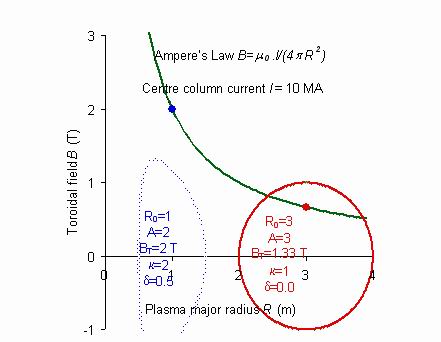
Figure 12. The toroidal magnetic field B as a function of radius for a centre rod current I of 10 MA. The field grows larger as the plasma
radius decreases according to Ampere's Law. Higher shaping of the plasma (increased elongation and triangularity) increases the
effective field for a given plasma radius.
The theory was put to the test with the small tight aspect ratio tokamak START which ran at Culham from
1990 to 1998. It was a somewhat unofficial project steered by Programme Director Derek Robinson FRS,
assembled from spare parts by Tom Todd, and run by theoretician turned experimentalist Alan Sykes and
Mikhail Gryaznevich.
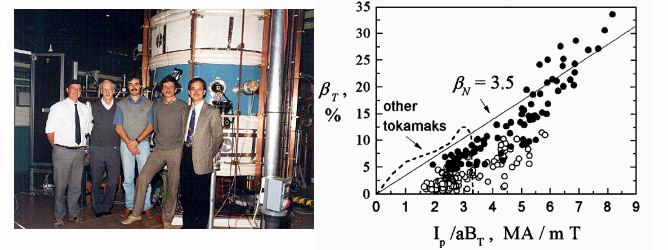
Figure 13. Left, the Start team in 1991. From the left, Alan Sykes ,Dick Colchin, Edson Del Bosco, Mikhail Gryaznevich and
Martin Peng [16]. On the right. the plasma pressure as measured on the START spherical tokamak by Gryaznevich et al [17].
It soon had impressive beta values a factor three better than previous results as shown in figure 13 from the
paper by Gryaznevich et al [17]. It was helped by the ability of spherical tokamaks to give impressive
photographs of the whole plasma, as was shown in figure 1.
These results inspired a new generation of larger spherical tokamaks around the world. MAST at Culham and
NSTX at Princeton showed that confinement times could be more favourable for spherical tokamaks. The
experimental observation of the bootstrap current, driven by plasma pressure gradients, had been predicted
theoretically by Bickerton, Connor and Taylor in 1971 [18] and observed experimentally on the Princeton
tokamak TFTR by Zarnstorff et al, [19] in 1988 allowing the prospect of a power plant with reduced external
current drive.
However, proposals for fusion power using a normal metal centre column had difficulties in that the power
dissipation required large cooling plants and frequent replacement due to neutron damage. In 1998 in their
paper "Spherical Tokamak route to Fusion Power" Stambaugh et al. [20] proposed a JET radius (R= 2.8 m)
power plant with a cooled copper centre rod. It was soon followed by similar sized projects from Voss et al
[21] at Culham and the US ARIES project by Najmabadi et al [22]. None of the projects were built. Much
power was lost cooling the centre column, which needed to be replaced at intervals because of radiation
damage. The conclusion was clear. Superconductors are necessary to allow the higher fields and lower energy
dissipation from the centre column.
High Temperature Superconductors
Ordinary low temperature superconductors date back to 1911 when Onnes demonstrated the complete
disappearance of electrical conductivity in mercury at 4.2K. Superconductivity is a quantum mechanical
phenomena and it took until 1957 for Bardeen, Cooper and Schrieffer [23] to explain it satisfactorily. Electrons
attract positive ions, which interact weakly with other positive ions through electron-phonon interactions to
form an attractive bond, which overcomes the Ampere"s law Coulomb barrier. A "Cooper pair" ground state
of two electrons with zero net spin is created, which has an energy below the normal electron Fermi energy,
which can be occupied at low enough temperatures. The electron-phonon energy is very weak, of order a
milli-electron volt, and other non-superconducting states soon become occupied at modest temperatures
above 4.2K and superconductivity is lost.

Figure 14. The perovskite structure the high temperature superconductor YBa2Cu3O7-x. The pure compound (x=0) is antiferromagnetic but
at other levels electrons in the two-dimensional planes of copper and oxygen atoms form spin density waves and create Cooper pairs of
spin zero which condense at low temperatures to form a superconducting Bose condensate.
Figure 15. Properties of a typical HTS superconductor. Very high current densities ~300 A/cm can be achieved at high magnetic fields
~25T and at relatively low temperatures ~20K. From Gryaznevich[25].
Their importance is three-fold as illustrated in figure 15. Firstly, their superconducting temperatures can be
much higher than for low temperature superconductors, say 92 K for YBCO, thus reducing cryogenic power
needs. Secondly, superconductivity can exist at much higher magnetic fields, particularly if the temperature is
reduced well below the transition temperature. This extends the plasma physics: a given fusion power can be
achieved at lower volumes by a higher toroidal field. Thirdly, the current carrying capacity for a given area of
conductor is increased allowing a given current to be carried in more slender cables as discussed in the next
section. Because of these properties, high temperature superconductors have the potential to be a game-
changer for magnetic confinement fusion research.
The opportunity presented by spherical tokamaks and high
temperature superconductors
The disadvantage of the spherical tokamak is clear. The need for a slender centre column imposes engineering
and radial space constraints on any design. With low temperature superconductors the need for a neutron
shield thicker than a metre makes a spherical tokamak unfeasible. However, the higher fields and operating
temperature of high temperature superconductors opens a new opportunity.

Figure 16. The variation of tokamak major radius (lines) given by lower aspect ratio (X-axis) by and higher magnetic toroidal fields
(Yaxis). The figure uses the equation shown from Costley's paper [26] in this issue, using the relation Costley noted for the change in
elongation (κ) with aspect ratio. The data are scaled to the ITER operating point.
Alan Costley's paper [26] in this volume gives in his equation 2 the expression for the fusion triple product in
terms of tokamak size R02, toroidal field BT3 and shape
τ7/2/A3 for a tokamak plasma operating in steady-state
conditions. It encapsulates the opportunities for smaller tokamaks given by higher field and tighter aspect
ratio.
 (4)
(4)
As mentioned earlier, the elongation κ increases naturally with decreasing aspect ratio A. The empirical
relationship has been evaluated by Costley as κ = 3.54/A1/2. Incorporating this into the above equation gives
nTτE α H2.q-3.R2.B3.A-19/4
(5)
In this equation the terms H2/q3 can be thought of as constant values to be achieved. The equation applies
generally, but scaling to ITER which has R0=6.2 m, B0=5.3 T, and A0=3.1, it becomes
R=R0.(B/B0)-3/2.(A/A0)19/8
(6)
So that the plasma major radius for ITER fusion conditions scales inversely as the toroidal field to the power
3/2, and rather strongly with aspect ratio to the power 19/8. Figure 16 illustrates this relationship when
presented as contours of the plasma major radius R as a function of toroidal field B
and aspect ratio A at
constant nTτE, H and q.
Papers in this issue
The first paper is by Dan Clery [27] whose brief was to tell us of the non-tokamak ways to fusion power, excluding
the stellarator - a relative of the tokamak. It is a characteristic of new technologies that they involve risk. Some
revisit abandoned schemes from the early days of fusion research. We have seen in the case of inertial fusion
that, despite enormous investment, strange unexpected instabilities have meant that they did not achieve the
results their big codes had predicted. That is a message for all to take on board! Our computer codes need to
contain all the relevant physics. If all the relevant physics is not yet known, then some risks must be taken.
These can be minimised by incremental development where difficulties are solved one-by-one and by small
increments rather than all together in a single big increment. The uniquely safe and inexhaustible nature of
fusion power makes it such a prize that investors are quite willing to take risks. One conclusion for this
meeting is that: "To accelerate fusion we need to take some calculated risks."
The second paper is by Tony Donné [28] the Programme Manager of EUROfusion. It gives a systematic outline of
the Eurofusion "Roadmap" and the eight "missions" that EUROfusion is aiming to address, such as heat-
exhaust systems, neutron resistant materials and tritium self-sufficiency, needed to design the European
DEMO reactor [29]. Donné stressed the need for integration of these, the involvement of industry, and for a 14
MeV neutron source for materials testing.
Guenter Janeschitz's paper [30] used his experience gained at ITER and from his leadership of the Karlsruhe
International School on Fusion Technologies to take an alternative view of tokamak power plant design. His
paper takes the view that the tokamak outer breeding wall, building construction and licensing costs tend to
be independent of plasma size, so that larger sizes and powers are optimal. His paper does discuss shape
effects in detail and suggests an ideal aspect ratio of 2.5
Yutaka Kamada has not submitted a paper, but he spoke of the new JET-sized low-temperature
superconductor JapanTokamak-60cmSuperAdvanced JT-60SA. It should be ready by 2020 and will be able to
increase the lead the Japanese already have in approaching higher triple products in non-tritium plasmas [30].
Some details are shown in table 2 and figures 17 and 18 from the official website [30].
| - | JT-60SA | ITER |
| Major radius (m) | ~3.0 | ~6.2 |
| Minor radius (m) | <1.18 | <2.0 |
| Plasma current (MA) | <5.5 | <15 |
| On-axis toroidal field (T)/TF Conductor | <2.3/NbSn | <5.3/Nb3Sn |
| Plasma elongation | <2.0 | <1.8 |
| Plasma triangularity | <0.5 | <0.5 |
| Plasma volume (m3 | ~140 | ~840 |
| Inductive pulse length (s) | 100 | >400 |
Table 2. The parameters of the new Japanese tokamak JT-60SA compared with ITER. [25]
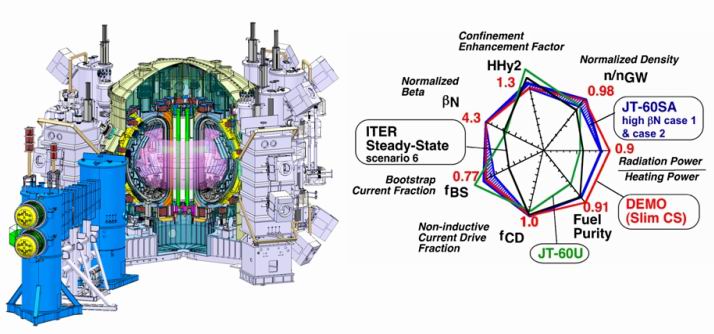
Figure 17. Left: A cut-away view of the JT-60SA tokamak. It has conventional low temperature superconducting coils giving a toroidal
field of 2.3 T. Its plasma major radius is 3m making it around the size of JET. It is not capable of D-T operations [25]. Right: Important
operational parameters of the JT-60SA tokamak compared with the earlier JT-60-I, ITER and DEMO [25].
Since the 1957 ZETA experiments at Harwell, plasma instabilities have been the bugbear of fusion. Howard
Wilson's paper [32] gives us hope that fusion theory could help to mitigate their effects. He explained how "the
most compact fusion reactors will benefit from high confinement." He emphasized the different strategies for
the development of fusion and their different balances of risk and speed.
Ian Chapman's paper [33] speaks of the very exciting UKAEA scene at present including the role of JET and its
programme in support of ITER. MAST upgrade is due to be running later this year and the meeting wished it
good fortune! We all have much to learn from their new superX divertor for carrying the external energy
away, and ELM mitigation operations. We wish for record results from the coming JET D-T campaign in a
year or so. I am sure the whole UK fusion community as represented here wants to work with you in making
the most of these opportunities.
The two papers by Hartmut Zohm [34] and Alan Costley [26] form a debate on tokamak size that comes to some
conclusions. Both agree that toroidal field dependence is crucial to the debate. Both agree that smaller size
does generally go with higher fields. Both agree that engineering constraints can limit performance with
today's materials. The Costley side of the debate also considers aspect ratio A and elongation
κ, as important
variables, which Zohm agreed needs to be investigated further. Zohm recognised HTS magnets might permit
smaller size, but felt improved performance would be needed. Costley also points out that the beta-
independent versions of the ITER confinement time scalings - and it is now generally accepted that at reactor
relevant low collisionalities the confinement time is independent of beta - lead to significantly lower fusion
power for a given fusion gain. Lower fusion power will aid the construction of smaller fusion tokamaks.
Melanie Windridge's paper [35] considers the opportunity given by High Temperature Superconducting magnets
(HTS). These can operate in magnetic fields of up to 20 Tesla, have higher current density than conventional
low temperature magnets and require less cryogenic cooling. This is the way forward proposed by Tokamak
energy, Princeton Plasma Physics Laboratory and MIT. The disadvantage of HTS at this stage is that it is not a
mature technology, so not without risk and not cheap. That is why Tokamak Energy have set up an HTS team
in Oxfordshire, where there is unrivalled experience in magnet technologies, to develop HTS techniques.
Jon Menard's paper [36] describes his Fusion Nuclear Science Facility with spherical tokamaks and HTS magnets.
His paper gives the detailed quantitative analysis of the variation of performance with aspect ratio self-
consistently with elongation, which many at the meeting had been asking for. Designs with aspect ratio
around two were possible but their confinement times remain an unsolved issue. The fusion community wish
him good luck with this project and in getting NSTX-upgrade back running again. World-wide fusion
projects are great, but we need additional different projects also. There is a considerable risk in putting all
your eggs into one basket.
Dennis Whyte's paper [37] delighted us all with his news. $50M of private money from Commonwealth Fusion
Systems will be invested to develop HTS magnets and for detailed design of the Smallest Possible Affordable
Robust Compact tokamak (SPARC). The fusion community congratulates him and the whole team for getting
this project under way. We wish them good fortune.
Elizabeth Surrey's paper [38] concentrates on the engineering challenges of accelerated demonstrator systems
relevant to a fusion power plant. A detailed discussion is given of the component systems relevant to a fusion
power plant. Also discussed are the need to demonstrate tritium self-sufficiency, issues relating to the
economic production of electricity, remote handling schemes, the control of the plasma, safety and licensing
by a nuclear authority. She stressed the need for an integrated approach to these, involving industry and
considering the supply chain at an early stage. Computational engineering and verification would be
important. Her paper did not dwell on the key engineering challenge of smaller tokamaks. These have a
general problem of how the limited radial space available for the central column and its radiation shield can
adequately reduce heat deposition and radiation damage.
George Smith [39] gave us some answers to these questions. There are new materials such as the cemented
tungsten carbides - familiar from tool steel cutting heads. They can combine high strength and toughness with
very high temperature operations and good neutron and gamma shielding. His paper reviews the engineering
properties of pure tungsten carbides, and treats in some detail the properties of the candidate cermet material,
WC-FeCr. The problem of how to manufacture the large shield of this type required for a power plant remains
open.
Nick Lopes Cardoso [40] addressed the economic reasons that governments and utilities may invest in the
Eurofusion road map power plant. He thought it impossible to introduce fusion power on the timescale
envisaged by the Paris 2015 agreement on climate change. The rate of growth of the different energy markets
like fission, wind and solar are shown to have been remarkably similar with a doubling time of around 2.5
years. Energy is a market, and a very large one too! However growth rates will all depend on the product
offered. He introduced a "Valley of death" when the time-scale for the return on capital in a power plant is
much greater than the desired doubling time for growth. However if faster fusion can give us a modular
power plant at the right cost and time-scale, industry will buy it and it could be implemented on the
timescales considered as necessary by energy policy makers. The private investors to faster fusion are the
proof of this.
The meeting posed the question "Can development of fusion power be accelerated?" We have heard enough
to understand that it can be accelerated, not by pursuing a single line of development alone, but by pursuing
several new ideas in parallel, and especially those based on higher field, lower aspect ratio and lower power
devices. In his final round up comments, Mike Zarnstoff gave us the good summary sentence: "de-risk at
minimum size".
In conclusion I would like to thank several people for making this meeting a success. First the organising
committee, Jack Connor, Melanie Windridge, Dennis Whyte and Guenter Janeschitz for getting the
programme together and constant support. The programme chairs, and especially Mike Zarnstoff in the last
session, ensured that the discussions continued well, and that the whole meeting kept exactly to time. Special
thanks are due to Annabel Sturgess and all her helpers from the Society for organising the meeting so well and
to Bailey Fallon for help with the preparation of the papers for publication in the proceedings. Lastly thanks
are due to all the participants for their interest in fusion and their excellent questions, the speakers who have
educated us on their way to accelerating fusion, and my colleagues, Jack Connor, Melanie Windridge, Alan
Costley and David Kingham for helpful comments on the paper.
References
1. Eddington A. S. , 1920, Address to the British Association for the Advancement of Science, Cardiff.
https://archive.org/stream/reportofbritisha20repo/reportofbritisha20repo_djvu.txt
2. Einstein A, 1905, Does the inertia of a body depend upon its energy content? Annalen der Physik, 18, 639-643, English translations: http://www.fourmilab.ch/etexts/einstein/E_mc2/www/
3. Aston F. W.1920, Isotopes and atomic weights, Nature 105, p. 617
http://www.chemteam.info/Chemistory/Aston-MassSpec.html
4. 2012, Pricing sunshine: the rise of solar energy. The Economist
www.economist.com/graphic-detail/2012/12/28/pricing-sunshine
5. Lawson J., 1955 Harwell Report A.E.R.E GP/R 1807 https://www.euro-fusion.org/wpcms/wp-
content/uploads/2012/10/dec05-aere-gpr1807.pdf
6. Thomson, G.P. and Blackman M. 1946, British patent 817,681. Improvements in Gas Discharge Apparatus
for Producing Thermonuclear Reactions in Haines M G, 1996, Plasma Phys. Control. Fusion 38, 643,
http://iopscience.iop.org/article/10.1088/0741-3335/38/5/001
7. Pollock J. A. and Barraclough S. 1905, Proc. R. Soc. New South Wales 39 131
8. Peacock N. J., Robinson D. C., Forrest M J. , Wilcock P D., and Sannikov V V, Measurement of the electron
temperature by Thomson scattering in Tokamak T3, Nature 224 488-490.
doi:10.1038/224488a0
9. Robinson D. C., Windsor C. G., Keilhacker M., Lawson J. D. and Pert G. J., 1999, The approach to ignited
plasma, Phil. Trans. R. Soc. Lond. A 357,371-640 http://rsta.royalsocietypublishing.org/content/357/1752/
10. Bickerton R. J., History of the approach to ignition, 1999 Phil. Trans. R. Soc. Lond. A 357 397-413; 11. The European Fusion Education Network: Fusion Research Today: http://www.fusenet.eu/node/42).
Figure:
http://www.fusenet.eu/sites/default/files/moores_law.jpg
12. Bent Flyvbjerg, 2014, What You Should Know About Megaprojects and Why: An Overview, Project
Management Journal, April/May 2014, https://papers.ssrn.com/sol3/papers.cfm?abstract_id=2424835
13. Madia and Associates, 2013, Final Report of the 2013 ITER Management Assessment,
http://www.firefusionpower.org/2013-iter-management-assessment.pdf
14. A Sykes, M F Turner, and S. Patel, 1983, Proceedings of the 11th European Conf. on CFPP, Aachen, Vol. 2, p.
363.
15. Y-K Martin Peng, 1984, Spherical Torus, Compact Fusion at Low Yield", ORNL/FEDC-87/7 (December
1984)
16. Peng Y-K.M. and Strickler D.J. 1986 Features of spherical torus plasmas Nucl. Fusion 26 769
17. Gryaznevich M et al, Achievement of Record β in the START Spherical Tokamak, Phys. Rev. Letters 80, pp
3973-3975, 1998 https://doi.org/10.1103/PhysRevLett.80.3972
18. Bickerton R J, Connor J W and Taylor J B, 1971 Nature Phys. Sci. 229 110,
https://www.nature.com/articles/physci229110a0
19. Zarnstorff M. C., Bell M. G., Bitter M., Goldston R. J., Grek B., Hawryluk R. J., Hill K., D. Johnson D.,
McCune D., Park H., Ramsey A., Taylor G., and Wieland R., 1968, Bootstrap current in TFTR, Phys. Rev. Lett.
60, 1306, https://journals.aps.org/prl/abstract/10.1103/PhysRevLett.60.1306
20. Stambaugh R., Chan V., Miller, M Schaffer 1998, The Spherical Tokamak route to Fusion Power, Fusion
Technology 33 p1, https://www.tandfonline.com/doi/abs/10.13182/FST33-1
21. Voss G.M., Davis S., Dnestrovskij A., Kirk A., Knight P.J., Loughlin M., O'Brien M.H., Sychugov D.,
Tabasso A., and Wilson H.R., 2008 Conceptual design of a component test facility based on the spherical
tokamak. Fusion Engineering and Design, 83, 10-12, Pages 1648-1653
22. Najmabadi F, and the ARIES Team, 2003, Spherical torus concept as power plants - the ARIES-ST study,
Fusion Engineering and Design, 65, Issue 2, Pages 143-164, https://doi.org/10.1016/S0920-3796(02)00302-
23. Bardeen J., Cooper L. N., and Schrieffer J. R., 1957 Theory of Superconductivity, Phys. Rev. 106, 162,
https://doi.org/10.1103/PhysRev.106.162
24. Bednorz J. G. and Mueller K. A. Z. 1986, Possible high Tc superconductivity in the Ba-La-Cu-O system,
Zeitschrift fur Physik B Condensed Matter 64(2):189-193: https://link.springer.com/article/10.1007/BF01303701
25. Gryaznevich M. 2011 A quest for record high beta in tokamaks. In ITER-IAEA-ICTP Workshop. Trieste, Italy,
3-14 October 2011. See http://indico.ictp.it/event/a10172/session/ 26/contribution/16/material/0/0.pdf.
26. Costley A. E. 2019 Towards a compact spherical tokamak fusion pilot plant. Phil. Trans. R. Soc. A 377
, 20170439. (doi:10.1098/rsta.2017.0439)
26. EUROfusion, 2012 A roadmap to the realisation of fusion energy, https://www.euro-
fusion.org/fileadmin/user_upload/EUROfusion/Documents/Roadmap.pdf
27. Clery D. 2019 Alternatives to tokamaks: a faster-better-cheaper route to fusion energy?
Phil. Trans. R. Soc. A 377, 20170431. (doi:10.1098/rsta.2017.0431)
28. Donné A. J. H. 2019 The European roadmap towards fusion electricity.
Phil. Trans. R. Soc. A 377, 20170432. (doi:10.1098/rsta.2017.0432)
29. EUROfusion. 2012 A roadmap to the realisation of fusion energy.
See https://www.eurofusion.org/?leadmin/user_upload/EUROfusion/Documents/Roadmap.pdf.
30. Janeschitz G. 2019 An economical viable tokamak fusion reactor based on the ITER experience.
Phil. Trans. R. Soc. A377, 20170433. (doi:10.1098/rsta.2017.0433)
31. The JT-60SA Advanced Superconducting Tokamak. See http://www.jt60sa.org/b/index.htm.
32. Wilson H. 2019 The impact of plasma physics on the timescale to a tokamak fusion power plant.
Phil. Trans. R. Soc. A 377, 20170435. (doi:10.1098/rsta.2017.0435)
33. Chapman I.T., Morris A. W. on behalf of the UKAEA Team and collaborators. 2019
UKAEA capabilities to address the challenges on the path to delivering fusion power.
Phil. Trans. R. Soc . A 377, 20170436. (doi:10.1098/rsta.2017.0436)
34. Zohm H. 2019 On the size of tokamak fusion power plants. Phil.Trans.R.Soc. A377
,20170437. (doi:10.1098/rsta.2017.0437)
35. Windridge M. 2019 Smaller and quicker with spherical tokamaks and high-temperature superconductors.
Phil. Trans. R. Soc. A 377, 20170438. (doi:10.1098/rsta.2017.0438)
36. Menard J.E., 2019 Compact steady-state tokamak performance dependence on magnet and core physics limits.
Phil. Trans. R. Soc. A 377, 20170440. (doi:10.1098/rsta.2017.0440)
37. Whyte D. 2019 Small, modular and economically attractive fusion enabled by high temperature superconductors.
Phil.Trans.R.Soc. A377 , 20180354. (doi:10.1098/rsta.2018.0354)
38. Surrey E., 2019 Engineering challenges for accelerated fusion demonstrators.
Phil.Trans.R.Soc. A 377 , 20170442. (doi:10.1098/rsta.2017.0442)
39. Humphry-Baker S.A., Smith G.D.W., 2019 Shielding materials in the compact spherical tokamak.
Phil. Trans. R. Soc. A377, 20170443. (doi:10.1098/rsta.2017.0443).
40. Cardozo N.J.L., 2019 Economic aspects of the deployment of fusion energy: the valley of death
and the innovation cycle. Phil. Trans. R. Soc. A 377, 20170444. (doi:10.1098/rsta.2017.0444)
27. The JT-60SA advanced tokamak website: http://www.jt60sa.org/b/index.htm
17. Gryaznevich, M., 2011, ITER-IAEA-ICTP Workshop, Trieste, Italy, 3-14 October 2011
http://indico.ictp.it/event/a10172/session/26/contribution/16/material/0/0.pdf
Copyright 2019: Colin Windsor: Last updated 22/4/2019

 As approved for publication by Phil.Trans A 5/12/18:
C Windsor 2019 Phil.Trans A 2141
As approved for publication by Phil.Trans A 5/12/18:
C Windsor 2019 Phil.Trans A 2141














 (4)
(4)
